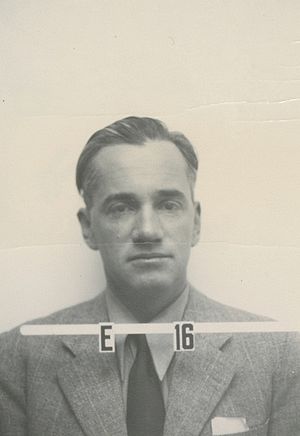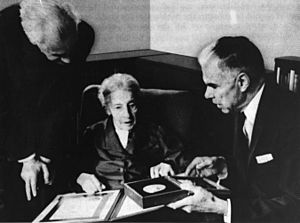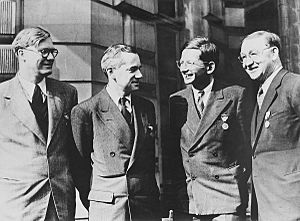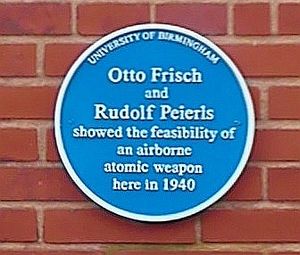Otto Robert Frisch facts for kids
Quick facts for kids
Otto Robert Frisch
|
|
|---|---|

Otto Robert Frisch's wartime Los Alamos ID badge photo.
|
|
| Born | 1 October 1904 |
| Died | 22 September 1979 (aged 74) Cambridge, United Kingdom
|
| Nationality | Austrian |
| Citizenship | Austria United Kingdom |
| Known for | Atomic bomb |
| Awards | Fellow of the Royal Society |
| Scientific career | |
| Fields | Physics |
| Influences | Rudolf Peierls |
| Signature | |
 |
|
Otto Robert Frisch was an important scientist born in Austria who later became British. He was a physicist who studied nuclear physics. With his aunt, Lise Meitner, he helped explain how nuclear fission works. This is a process where an atom's center splits apart. He also helped find the pieces left over after fission. Later, with Rudolf Peierls, he created the first ideas for how an atomic bomb could be made to explode in 1940.
Contents
Early Life and Education
Otto Frisch was born in Vienna, Austria, in 1904. His family was Jewish. His father, Justinian Frisch, was a painter, and his mother, Auguste Meitner Frisch, was a concert pianist. Otto was good at art and music, but he also loved physics, just like his aunt, Lise Meitner. He went to the University of Vienna and finished his studies in 1926. His early work looked at how tiny particles called electrons affected salts.
Discoveries in Physics
After working in a few labs in Germany, Frisch got a job in Hamburg. He worked with Otto Stern, a scientist who won the Nobel Prize. While there, Frisch studied how atoms move and bounce off crystal surfaces. He also proved that the magnetic moment of a proton was much bigger than people thought before. A proton is a tiny part of an atom's center.
Moving to England
In 1933, Adolf Hitler became the leader of Germany. Because of this, Otto Robert Frisch decided to move to London. He started working at Birkbeck College with physicist Patrick Maynard Stuart Blackett. They worked on cloud chambers, which are tools used to see the paths of tiny particles, and on making things artificially radioactive.
Specializing in Nuclear Physics
After London, Frisch spent five years in Copenhagen with Niels Bohr, another famous physicist. During this time, he focused more and more on nuclear physics. He became especially good at studying neutrons, which are neutral particles found in the center of atoms.
Understanding Nuclear Fission

During the Christmas holidays in 1938, Otto Frisch visited his aunt, Lise Meitner, in Sweden. While he was there, she got important news. Two scientists in Berlin, Otto Hahn and Fritz Strassmann, had found something amazing. They discovered that when a neutron hit a uranium atom, it created a new element called barium. Hahn wrote to Meitner, calling this a "bursting" of the uranium nucleus.
Frisch and Meitner thought about this news. They came up with the idea that the uranium atom's center had actually split into two smaller pieces. They explained how this process worked and figured out how much energy would be released. Frisch then came up with the name "fission" for this process. He borrowed the word from biology, where it describes how cells divide.
Because of the political situation in Nazi Germany, Hahn and Strassmann, who were not Jewish, had to publish their findings separately from Meitner and Frisch, who were Jewish. Hahn's paper described the experiment and finding barium. Meitner and Frisch's paper explained the science behind why it happened.
Frisch went back to Copenhagen and quickly managed to find the pieces that were created when atoms split. Many people believe that Meitner and Frisch should have won a Nobel Prize for their big contributions to understanding fission.
The Atomic Bomb Idea
In mid-1939, Frisch left Denmark for a short trip to Birmingham, England. But then World War II started, and he couldn't go back. With the war on his mind, he and physicist Rudolf Peierls wrote an important document called the Frisch–Peierls memorandum. This was the first paper to explain how an atomic explosion could be created.
They suggested using a special type of uranium called uranium-235. They figured out that only a small amount of this uranium would be needed to start a chain reaction. This small amount is called a critical mass. They also thought that regular explosives could be used to bring the uranium together quickly, causing a huge explosion. The memorandum even predicted the effects of such an explosion, from the initial blast to the dangerous fallout that would follow.
This memorandum was very important. It became the basis for Britain's project to build an atomic device, called the Tube Alloys project. It also influenced the American Manhattan Project, where Frisch later worked as part of the British team. Frisch became a British citizen quickly in 1943 so he could go to America and help with the project.
Working on the Manhattan Project
In 1944, Frisch worked at Los Alamos National Laboratory in the United States. He led a group that had to figure out the exact amount of enriched uranium needed to create a critical mass. This is the amount of uranium that can keep a nuclear chain reaction going.
He did this by carefully stacking bars of enriched uranium. He would measure the increasing neutron activity as the stack got closer to the critical mass. One day, Frisch almost caused a dangerous reaction. He leaned over the stack, which he called the "Lady Godiva assembly". His body reflected neutrons back into the stack. He saw red lights, which usually flickered, glowing steadily. Realizing the danger, Frisch quickly pushed the bars apart with his hand. He later calculated that the radiation he received was "quite harmless," but if he had waited just two more seconds, it "would have been fatal." His experiments helped determine the exact amount of uranium needed for the Little Boy bomb, which was later used over Hiroshima.
Frisch also designed another experiment called the "dragon's tail" or "guillotine" experiment. In this test, a piece of uranium was dropped through a hole in a larger piece of uranium. For a tiny fraction of a second, this created a critical mass. Richard Feynman, another scientist, joked that it was "just like tickling the tail of a sleeping dragon" because of the brief danger. In about 3 milliseconds, the temperature shot up very quickly, and a huge number of extra neutrons were released.
Return to England

In 1946, Otto Frisch returned to England. He became the head of the nuclear physics division at the Atomic Energy Research Establishment in Harwell. For the next thirty years, he also taught at Cambridge University. He was a professor of Natural Philosophy and a fellow at Trinity College.
Before he retired, he designed a device called SWEEPNIK. This machine used a laser and a computer to measure tracks in bubble chambers, which are tools used to study tiny particles. Frisch saw that this idea could be used for other things, so he helped start a company called Laser-Scan Limited, now known as 1Spatial.
Retirement and Legacy
Otto Frisch retired from his teaching position in 1972, as required by university rules. He passed away on September 22, 1979. His work was very important in understanding how atoms split and in the early development of nuclear energy.
Images for kids
See also
 In Spanish: Otto Robert Frisch para niños
In Spanish: Otto Robert Frisch para niños



